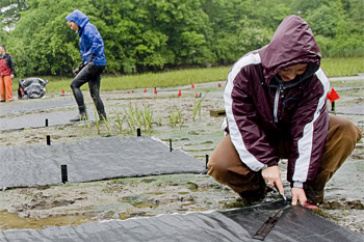UNH Testing Contamination-Capture Mats for Impact on Mud Creatures

Porous mats that remediate contaminated sediments are secured to the shallows of the Cocheco River south of Dover. UNH researchers are examining their impact on worms, clams and other invertebrates in the sediments below. Credit: Lisa Nugent, UNH Photo Services
DURHAM, N.H. - A successful remedy for contaminated sediments is being tested locally to determine its effects on creatures below.
Just south of Dover, during low tide, two 15' x 15' permeable mats peek out of the Cocheco River shallows. The mats are capturing contamination — like polyaromatic hydrocarbons (PAHs) — from river sediments, but University of New Hampshire researchers were recently surprised when they found coin-sized Harris mud crabs using the mats as refuge in addition to their usual hiding spot amidst vegetation on the river banks. Researchers are now conducting further studies to determine if worms, mussels and other invertebrates living in river bottoms can successfully co-exist with the mats that are helping to clean up their surrounding environment.
"We are asking some basic ecological questions: Can organisms survive under these mats? Will new organisms move into the area due to the addition of sediments on top of the mats?" says Wan-Jean Lee, research assistant for this N.H. Sea Grant-funded project and a UNH Ph.D. student.
Lee collected sediment samples from underneath the mats and from areas without mats to compare invertebrate communities found in each location. Although the long-term impacts are unknown, preliminary results indicate that the mats do not cause a significant difference in species diversity underneath them. However, fewer numbers of each species live under the mats than in open sediments, indicating that this remediation method may cause some slight changes to the underlying ecology.
Most of the PAHs in the Cocheco River sediments are carcinogenic remnants from the manufactured gas plant located on the river a century ago, explains Kevin Gardner, UNH associate professor of civil engineering. As the groundwater naturally moves up through the sediment depths, it carries PAHs with it to the top layers where clams, worms and other bottom-dwelling creatures are exposed to them. Many of these organisms are also near the bottom of the food chain, so contaminants they ingest or absorb may bioaccumulate in larger animals, including fish and, eventually, humans.
"A lot of the action happens at the bottom of lakes and rivers," Gardner says. "We need to recognize the huge role that sediment plays in harboring contaminants and in introducing contaminants to the aquatic food chain."
The mats are filled with compounds — such as the activated carbon found in kitchen faucet filters — that attach to the contaminants as the water flows through, keeping the undesirables inside the mat material. Fine sand or sediment is placed on top of the mats to help secure them in place. They remain effective for 20-50 years after installation, depending on the extent of site contamination, Gardner says.
It remains unclear how the sand on top of the mats will affect the creatures that may or may not choose to resettle there. This will require more time and will partially depend on the rate of natural sediment deposition, Lee explains. Last year, still early in the experiment, the sand was mostly uninhabited. She will collect additional samples this year to determine what, if any, changes have taken place, and will measure the PAH concentration in the invertebrates themselves.
Lee emphasizes the importance of long-term research to more accurately determine the biological impacts of remediation techniques. "The whole point of remediation is to restore the ecology," she said. "At this point, we aren't 100% sure how the invertebrate community will change, but that will continue to be the focus of our research this year," she adds.
Learn more about earlier research at the Cocheco with geotextile mats: /unhtoday/news/cj_nr/2008/june/bp16sediment.cfm
The University of New Hampshire, founded in 1866, is a world-class public research university with the feel of a New England liberal arts college. A land, sea, and space-grant university, UNH is the state's flagship public institution, enrolling 12,200 undergraduate and 2,200 graduate students.
-30-
Photographs available to download:
/unhtoday/sites/default/files/newsroom/img/cocheco/cocheco.jpg
Porous mats that remediate contaminated sediments are secured to the shallows of the Cocheco River south of Dover. UNH researchers are examining their impact on worms, clams and other invertebrates in the sediments below.
Credit: Lisa Nugent, UNH Photo Services
/unhtoday/sites/default/files/newsroom/img/cocheco/mat.jpg
Caption: A close-up of the inside of the mats, where reactive substances are distributed through a lofty fiber, where they trap and treat pollutants in the contaminated sediment.
Credit: Lisa Nugent, UNH Photo Services
-
Media Contact
Rebecca Irelan | Institute for the Study of Earth, Oceans, and Space | rebecca.irelan@unh.edu | 603-862-0990
Latest News
-
July 2, 2024
-
June 18, 2024
-
June 18, 2024
-
May 17, 2024
-
May 14, 2024

















































